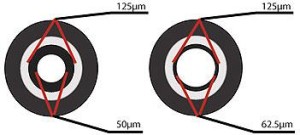About Multi-mode Optical Fiber
Multi-mode optical fiber is a kind of optical fiber mostly used in communication over short distances, for example, inside a building or for the campus. Typical multimode links have data rates of 10 Mbit/s to 10 Gbit/s over link lengths of up to 600 meters (2000 feet) - greater than sufficient for almost all premises applications.
Multimode fiber optic cable has a large diametral core which allows multiple modes of light to propagate. For this reason, large number of light reflections created because the light goes through the core increases, creating the ability for more data passing at a given time. Due to the high dispersion and attenuation rate using this type of fiber, the number of the signal is reduced over long distances. This application is commonly used in short distance, data and audio/video applications in LANs. Broadband RF signals, such as what fiber optic companies commonly use, can't be transmitted over multimode fiber.
Multimode fiber is generally 50/125 and 62.5/125 in construction. Which means that the core to cladding diameter ratio is 50 microns to 125 microns and 62.5 microns to 125 microns.
Multimode fibers are recognized by the OM ("optical mode") designation as outlined in the ISO/IEC 11801 standard.
- OM1 Fiber, for fiber with 200/500 MHz*km overfilled launch (OFL) bandwidth at 850/1300nm (typically 62.5/125um fiber)
- OM2 Fiber, for fiber with 500/500 MHz*km OFL bandwidth at 850/1300nm (typically 50/125um fiber)
- OM3 Fiber, for laser-optimized 50um fiber having 2000 MHz*km effective modal bandwidth (EMB, often known as laser bandwidth), created for 10 Gb/s transmission.
- OM4 Fiber, for laser-optimized 50um fiber having 4700 MHz*km EMB bandwidth made for 10 Gb/s, 40 Gb/s, and 100 Gb/s transmission.
Multi-mode optical fiber Types:
The transition between the core and cladding can be sharp, which is named a Step-Index Multimode Fiber, or a gradual transition, which is named a Graded-Index Multimode Fiber.
Step-Index Multimode Fiber - Because of its large core, a few of the light rays that constitute the digital pulse may travel a direct route, whereas others zigzag as they bounce off the cladding. These alternate paths result in the different groups of light rays, identified as modes, to reach separately at the receiving point. The pulse, an aggregate of different modes, starts to disseminate, losing its well-defined shape. The necessity to leave spacing between pulses to avoid overlapping limits the quantity of information which can be sent. This kind of fiber is most effective for transmission over short distances.
Graded-Index Multimode Fiber - Includes a core in that the refractive index diminishes gradually from the center axis out toward the cladding. The higher refractive index in the center makes the light rays moving down the axis advance more slowly than these near the cladding. Because of the graded index, light in the core curves helically rather than zigzag off the cladding, reducing its travel distance. The shortened path and the greater speed allow light at the periphery to reach a receiver at about the same time as the slow but straight rays in the core axis. The end result: digital pulse suffers less dispersion. This kind of fiber optic cable is most effective for local-area networks.
Applications
The device used for communications over multi-mode optical fiber is cheaper than that for single-mode optical fiber.Typical transmission speed and distance limits are 100 Mbit/s for distances up to 2km (100BASE-FX), 1 Gbit/s up to 1000m, and 10 Gbit/s up to 550m.
Due to its high capacity and reliability, multi-mode optical fiber usually used for backbone applications in buildings. A large number of users consider the advantages of fiber nearer to the user by running fiber to the desktop or to the zone. Standards-compliant architectures such as Centralized Cabling and fiber to the telecom enclosure offer users the opportunity to leverage the distance capabilities of fiber by centralizing electronics in telecommunications rooms, instead of having active electronics on each floor.
